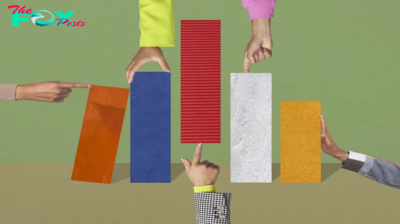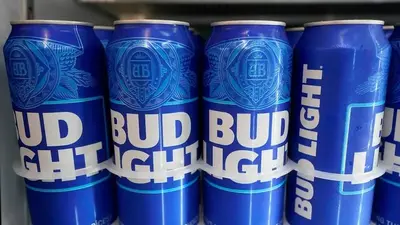Business
What it's like to experience Mercedes-Benz's Drive Pilot automated system
It was like a scene from a Science fiction film.
The Mercedes-Benz EQS sedan expertly steered, braked and accelerated on Southern California's Interstate 10 as I flipped through the pages of the Los Angeles Times, oblivious to the traffic encircling us.
I had deliberately relinquished all driving duties to the car's computer. Instead of monitoring the road, I was free to turn my attention to "other activities inside the vehicle," my passenger, Mercedes-Benz engineer Lucas Bolster, reminded me.
Ultrasonic sensors, LiDAR, cameras, microphones and a digital HD map installed in the car had up-to-date information on road geometry, route characteristics, traffic signs and special traffic events.
But then red lights started flashing in the cabin. The car's beeping got louder and pertinacious. I felt the seat belt yank on my shirt. It was time for the "fallback ready user" -- aka me -- to take over the helm.
If I did not comply in 10 seconds, the car's artificial intelligence would alert authorities.
Level 3 automated driving is no longer a driving fantasy. Mercedes-Benz, the sole automaker with government approval of the technology in the U.S., will roll out its "Drive Pilot" system in EQS and S-Class sedans later this year and early 2024.
The tech was introduced to "give you back time in a freeway traffic jam," according to a pre-recorded video I was required to watch before setting off on the freeway last month.
The EQS did not tailgate, brake hard or honk agitatedly at merging vehicles. How polite and computer-like. Yet the same question kept tugging at me as I daydreamed out the window: Why do we need this technology at all? Are humans really that awful at driving?
Automakers "dramatically overstate that humans are bad drivers to sell car technology," Phil Koopman, a professor at Carnegie Mellon University who has been working on self-driving car safety for more than 25 years, told ABC News. "Just 8 to 9% of vehicle fatalities are caused by distracted driving."
There are too many important questions that need to be addressed before this technology can be deployed widely, he said.
"Tech systems can fail more often than you want ... and when it doesn't work, it gets a bad outcome," Koopman said. "People are wired to trust things from a tech point of view. NHTSA [National Highway Traffic Safety Administration] is completely overwhelmed to regulate this technology ... it's like the Wild West out there and carmakers are exploiting this."

Mercedes says it's commitment to safety and reliability. It says it hired technical, legal, ethical, certification and safety experts to work together in the development of Drive Pilot. It's also the first automaker to introduce Level 1, Level 2 and now Level 3 automated driving technology to the U.S. market. Drive Pilot will be offered via subscription for 2024 S-Class and EQS Sedan models at a cost of $2,500.
Level 2 driver support systems require the driver to be engaged, responsive and ultimately reliable for the vehicle's operation. In Level 3, the system has complete control without human supervision, though the driver has to be prepared to take over when requested by the vehicle. A human driver is not needed in Level 4.

Just two states -- California and Nevada -- have certified Mercedes' Level 3 technology. European regulators approved Drive Pilot in late 2021. Last November, Mercedes, along with German company Bosch, got permission from government officials to equip vehicles with fully automated self-parking software. These vehicles drop drivers off at the Stuttgart Airport, park in pre-booked spots and return to drivers when summoned.
Drive Pilot has not caused any accidents in Germany since its launch, according to Mercedes. In the U.S., engineers tested the software in San Francisco, Los Angeles, Sacramento and San Diego before getting approval from the California DMV. Nevada signed off on the technology in January.
"We're required in the state of California to report all the mileage from our automated fleet and we've been doing that for a long time," Loren Macklem, a director at Mercedes-Benz Research & Development North America, told me. "We've accumulated over 100,000 miles of testing in traffic jams. We have a lot of experience with it."
He added, "We see a lot of opportunity in Level 3. It's a big step Mercedes has taken."
MORE: Mercedes-Benz's message for Tesla: 'We want to be most desirable electric vehicle luxury brand'
It's unclear when -- or if -- Drive Pilot will become available in other states.
"It's a case-by-case basis," Tom Brunner, senior manager for technical compliance at MBUSA, said. "We're still evaluating which states we're going to look at next."
Regulatory approval is just one step for automakers. Getting Americans to be comfortable with the Technology -- and accepting a computer driver -- may be the harder task. According to a 2022 study by the Pew Research Center, "Roughly 6-in-10 adults (63%) say they would not want to ride in a driverless passenger vehicle if they had the opportunity, while a much smaller share (37%) say they would want to do this."
Moreover, the study found that "larger shares of U.S. adults (44% vs. 26%) think the widespread use of driverless passenger vehicles is a bad idea for society than think it is a good idea."
Consumer confidence in fully automated, self-driving vehicles declined for a second consecutive year, according to the J.D. Power 2023 U.S. Mobility Confidence Index (MCI) study released this month.
"Automated driving technology is still very much in an evolving and testing stage with improvements occurring quickly. Consumers' understanding of where we are on the path to long-term automated mobility needs to be calibrated as today's systems are not designed to enable more risky driving," Bryan Reimer, a research scientist in the AgeLab at the MIT Center for Transportation and Logistics and a founder of MIT’s Advanced Vehicle Technology (AVT) Consortium, said in the JD Power study.
Self-driving technology "is mostly a case of car companies trying to get an edge," according to Daniel Sperling, a professor of civil engineering and environmental science and policy at UC Davis and a founding director of the Institute of Transportation Studies.
"The auto industry is being competitive," he told me. "Look at a car today versus five years ago. There are bigger screens and more tech. I am skeptical of putting a Level 3 car in the hands of American drivers. A lot can happen in 10 seconds. Many experts say Level 3 automated tech is a bad idea."
He went on, "This is Big Tech treating us as Guinea pigs."
In Mercedes' Drive Pilot system, the driver must respond to a takeover request within 10 seconds. If the driver does not answer, the vehicle's emergency stop procedure begins. The vehicle will brake, come to a full stop in its current lane, turn on the hazard lights and bring itself to a standstill. The Mercedes-Benz emergency call system is activated and the doors are unlocked for emergency personnel access.
Sperling pointed out that it can take up to 18 seconds for some drivers to become reengaged after surrendering the wheel to the computer. Research has shown that people need a fair amount of time to refocus cognitively, he said.
"There are several car companies that said they would not do Level 3 because it's too dangerous. This is really untested territory from a liability perspective," he added.

Sperling has not tested the Drive Pilot system yet, though he was able to experience Level 4 autonomous driving when he hailed a robotaxi a few weeks ago in Arizona.
"I felt isolated and vulnerable ... there was no one to talk to, no control," he said. "But by the end of the ride I said, 'That was OK. The computer seemed to be able to handle everything pretty well.'"
Sperling doubted, however, that Level 4 technology would be available for motorists in the foreseeable future.
"The industry is not looking at Level 4 as a consumer product. It won't be mass market," he said. "There's a big difference between buying a Level 4 car and taking a ride in a Level 4 robotaxi."
Added Koopman: "This is not a progression from Level 1, 2, 3, 4. We're not climbing a ladder. Companies are pushing as hard as they can to scale up -- and scale up aggressively with immature tech."
San Francisco's robotaxis, which are operated by Cruise and Waymo, have been under intense scrutiny in recent weeks. They've caused traffic backups, blocked streets and trapped passengers inside for 15 minutes. A female pedestrian was recently pinned under a Cruise robotaxi when another vehicle, driven by a human, struck the woman.
"The initial impact was severe and launched the pedestrian directly in front of the [autonomous vehicle]," which then "braked aggressively to minimize the impact," Cruise, which is backed by General Motors, said in a statement.
MORE: What it's like to ride in a self-driving taxi
Level 2 driver-assistance systems -- tech that is common in most new vehicles -- have been linked to nearly 400 crashes, some fatal, from July 1, 2021, through May 15, 2022, according to NHTSA, which ordered automakers to collect the data as safety concerns mounted from industry experts and critics. A Washington Post analysis of NHTSA data found that Teslas operating in Autopilot mode, the company's Level 2 technology, caused 736 crashes in the U.S. since 2019.
"The number of deaths and serious injuries associated with autopilot also has grown significantly," according to the outlet.
Mercedes engineers and executives said they are well aware of the headlines involving partially automated systems. Macklem noted Drive Pilot's limitations: it only works in daylight and on a pre-mapped freeway network approved by Mercedes. The vehicle will also cede control to the driver when there is construction, inclement weather, poor satellite reception or hard-to-read lane markings. Plus, the system caps the speed at 40 mph and there has to be a lead car for the program to engage.
"Mercedes has done this very thoughtfully and carefully," Macklem said.
"We've done a lot of studies ... starting in simulators, proving grounds and on real roads to make sure the system was safe," Bolster, who works closely with Macklem, said.

The gray, confusing area of Level 3 automated driving centers on liability: When the vehicle is dynamically driving, can the automaker be responsible for accidents and collisions?
"We take responsibility for the design and manufacturing of our products," Mercedes-Benz said in a statement to ABC News. "As a manufacturer, our scope of responsibility expands as the vehicle takes on more of the dynamic driving task. In the context of Drive Pilot, this means that if a customer uses the system as intended and instructed and the system fails to perform as designed, we stand behind our product. We are truly confident about the performance of our SAE-L3 system.
With Drive Pilot activated, the vehicle continues driving during a takeover request, and the vehicle handles time- and safety-critical situations. Generally, in the event of an accident, responsibility and liability are determined by the circumstances of each individual case. We will review these claims and take responsibility when the system is shown to have caused the collision and damages. If for example, a third party causes the collision, we may assess each party’s relative responsibility."

Koopman said legal loopholes still exist for Level 3, suggesting motorists could be accountable for incidents even when the vehicle is driving. Koopman, who blogs about autonomous driving, said he found a troubling paragraph in the Mercedes Drive Pilot user manual for U.K. drivers.
"In rare cases, the Drive Pilot may not respond to contact from other road users and, accordingly, may not request a takeover. This can also be the case with minor collisions," the manual states.
"The U.K. is not the U.S., but the phrasing is interesting nonetheless," Koopman wrote in a recent post. "This wording is in a pull-down 'note' that will not be seen by the owner reading the manual unless they open a legal 'warning' tab. So I'm guessing most owners won't see it."
Koopman argued that a duty of care law from the federal government would "install a measure of sanity" for drivers and "rein in this level of madness."
"Right now automakers are not liable," he pointed out. "Duty of care won't solve all the safety [concerns] but it's 90% of a solution."
My test-drive of Drive Pilot was fascinating, unnerving and, at times, frightening. Bolster assured me repeatedly to let go of my fear and let the car manage the traffic. When I asked him why drivers would want this tech, he paused.
"We spend a lot of time in our cars. It's a natural place, I think, to want to do other things," he replied.
So I did as told, taking my hands -- and eyes -- away from the road.
-

 Business5h ago
Business5h agoU.S. Antitrust Regulators Seek to Break Up Google, Force Sale of Chrome Browser
-

 Business5h ago
Business5h agoSuccessful White Men Alone Can’t Create America’s Economic Future
-

 Business10h ago
Business10h agoThe Rise of Silent Services
-

 Business21h ago
Business21h agoTim Latimer
-

 Business1d ago
Business1d agoCarbon offsets can help bring energy efficiency to low-income Americans − our Nashville data shows it could be a win for everyone
-

 Business1d ago
Business1d agoWorkplace diversity training programs are everywhere, but their effectiveness varies widely
-

 Business2d ago
Business2d agoFirm bosses urged to make use of Welsh language to revitalise rural economic system
-

 Business3d ago
Business3d agoDonor-advised funds are drawing a lot of assets besides cash – taking a bigger bite out of tax revenue than other kinds of charitable giving



























